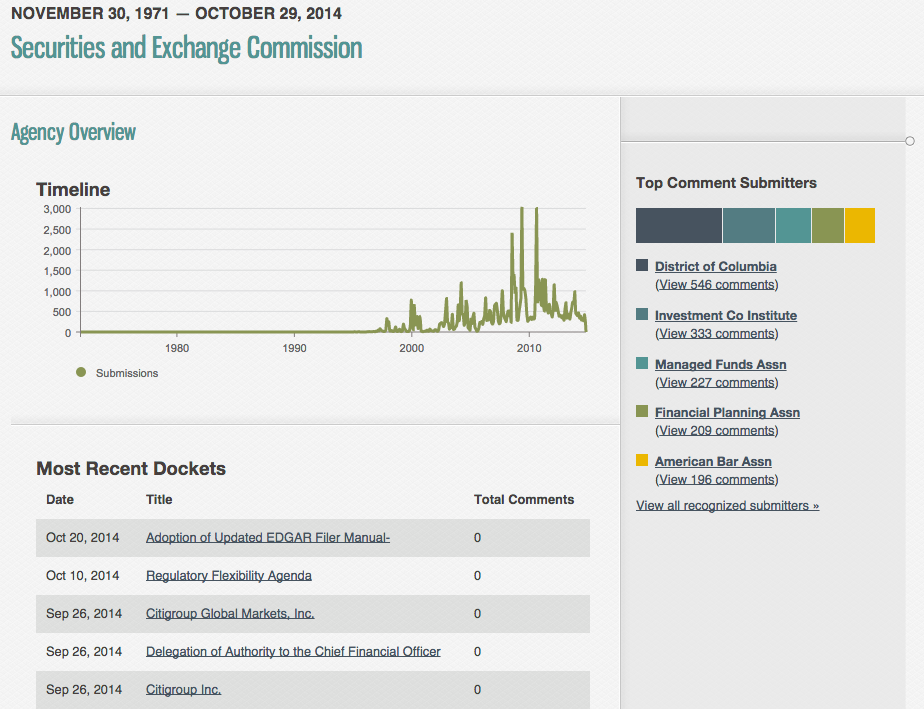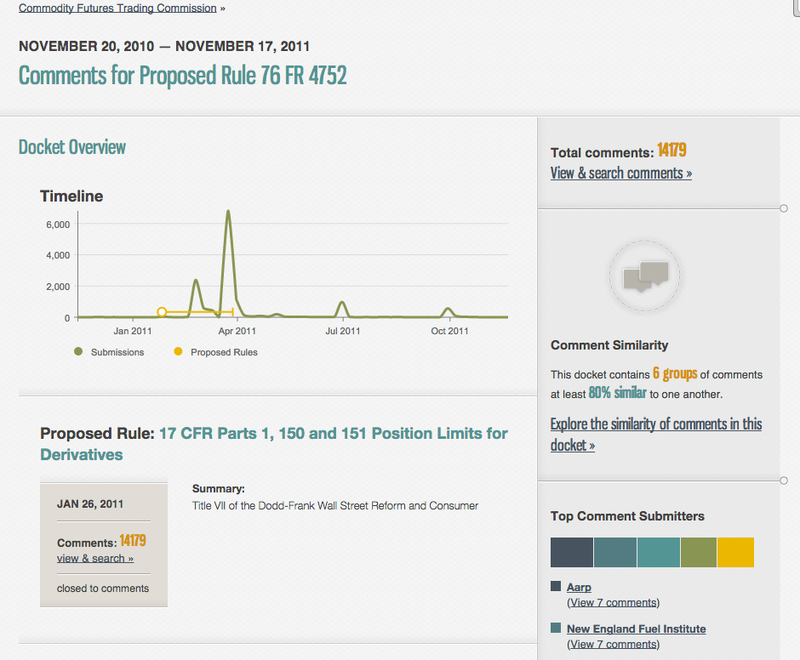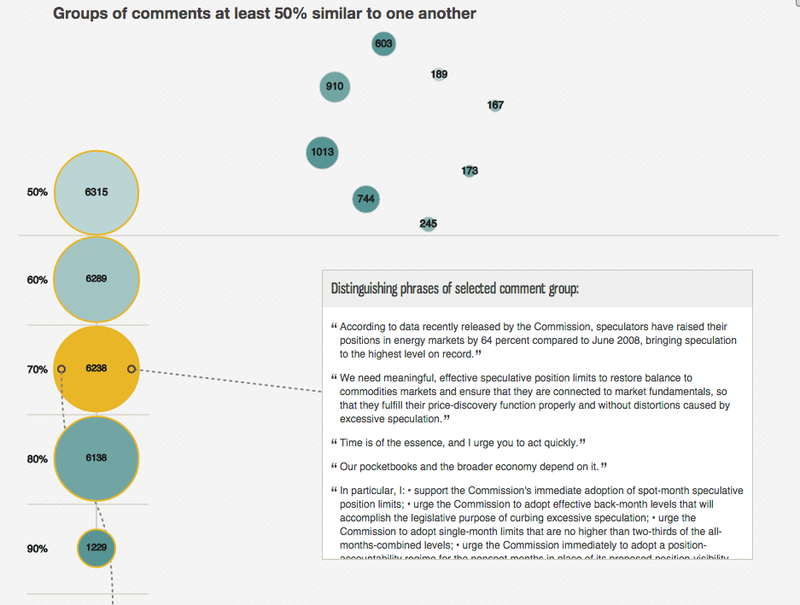Welcome to Docket Wrench, SEC and CFTC!

Sunlight is pleased to announce that we have now integrated regulatory data from both the Securities and Exchange Commission (SEC) and the Commodity Futures Trading Commission (CFTC) into our Docket Wrench tool.
Thanks to a generous grant supported by Transparency International, and in partnership with the Thomson Reuters Foundation, you can now view both regulatory proposals and comments received by these major federal agencies that oversee the nation’s financial markets. These two agencies do not participate in Regulations.gov, the central regulatory hub for the federal government that fuels Docket Wrench, so it took additional work to bring them into the fold.
Now the public can use our clustering analysis to show when executive branch agencies are being targeted by organized letter-writing campaigns. This is particularly crucial with the CFTC, which does not provide such analysis itself. The SEC has a system where the agency does its own analysis of these clusters, available online in its regulatory section as “type a,” “type b,” etc.
Here is a primer on how to dig in. If you have any questions, please do not hesitate to contact us.
How do I see an agency profile?
Search for “Securities and Exchange Commission” or “Commodity Futures Trade Commission” on Docket Wrench and in the search returns click on the bottom link under “Agencies.” You’ll find yourself here, where you’ll be able to see a timeline graphic showing regulatory actions over time. (Yes, the SEC did work before the 1990s, but that’s when our data begin.) Underneath the timeline graphic, you will find a section called “most recent dockets” and “most popular dockets.” (Remember that the comment-counts for “most popular” dockets could be considerably off for the SEC, since the agency counts clusters of letters with similar or identical language as one comment. Thus, the petition to require corporations to disclose political expenditures displays with 2,777 comments, although the total number of comments received is actually 1.2 million.)
To the right is a list of top “recognized” commenters. This is a somewhat rough analysis of the organizations submitting the most comments to the agency. It is is rough for two reasons:
- Because of the way agency data are displayed, it is sometimes difficult to extract the organizational affiliate of a particular commenter; and
- We list here only commenters who also have a political profile on our Influence Explorer tool. In other words, entities that make campaign contributions, report spending on federal lobbying, etc.
Despite these caveats, we see organizations that weigh in the most tend to be trade associations representing the financial community, such as the Investment Company Institute, the Managed Funds Association and the Financial Planning Association. Click on any of those organizations’ names to see profiles of their regulatory commenting activity.

How do I see activity for a particular regulation?
Let’s say you are interested in the CFTC’s proposal on position limits, which attracted over 14,000 comments, more than any other proposal by the agency. First you need to search for and find the regulatory docket in question. This can be a bit tricky, as sometimes regulations are labeled by technical language that you may not know. However, in this case, a simple search for “position limits” on Docket Wrench returns the correct link at the top of the page.
Once on this page, you will be able to see a timeline for regulatory proposals at the top center of the page. Below are the iterations of the proposal itself, which you can click on to see the actual language. To the right, on the top, is the total comment count; if you click right below, where it says “view & search comments,” you will be taken to a link with all 14,000-plus comments arranged over several pages. On the bottom-right are the top “comment submitters,” with the same caveats as above — this is a rough look at the organizations that commented the most on this proposal. The link in the middle-right of the page, which says “comment similarity,” is where you can find the tool to help you find clusters of similar comments.

How do I see the comment clusters for a given regulation?
If you follow the instructions above, selecting a particular regulation and clicking on the middle-right link, where it says “explore the similarity of comments in this docket,” you will come to a page that shows comment clusters for that regulation. Here is the comment similarity page for the position limits rule. You will see a series of bubbles. At the top is a summary bubble. You will see how many comments are similar to each other and by how much. In this case, 73 percent of the comments have at least 50 percent similarity to one or more comments. This means that you are quite likely to find significant number of letters that are the results of letter-writing campaigns.
To explore further, scroll down. You will see more bubbles. Each bubble represents a group of comments with similar language. The higher the percentage of similarity, the more chance you will find a group of letters that originated in a single model letter or alert circulated by an organization. As you move your mouse over the bubbles, sample language will pop up for the letters contained in this cluster. In this case, even at the least restrictive level — the 50 percent level — all the letters appear to have similar language to each other.
For example, you can see the following text in all of the bubbles: “Time is of the essence, and I urge you to act quickly. Our pocketbooks and the broader economy depend on it.” When we encountered this back in 2011, our reporter found that the language was traceable to an alert posted by an organization called “Stop Oil Speculation Now,” which could be linked to the airline and petroleum marketing industries. Indeed, if you attempt to visit the website now, you are redirected to a group called “Airlines for America.”

We hope you enjoy the new features of Docket Wrench, and we’re excited to see what you uncover!

